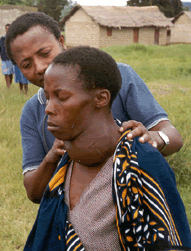A Primary Immune Deficiency Disorder is present when a body part is missing or is unable to function normally, these are caused by genetic and intermal problems, increasing susceptibility to infections. It is a broad heading for many World Health Organisation recognised deficiencies.
It has been estimated that there are 100 different primary immunodeficiency diseases. All are genetic conditions in which specific cells of the immune system do not function properly. Clinical symptoms range from mild or nonexistent as in the case of selective IgA deficiency to severe symptoms as in the case of severe combined immunodeficiency (SCID), commonly referred to as "bubble-boy" syndrome.
Possible types of Primary Immune Deficiency Disorder:
Antibody Deficiencies An antibody is a protein made by white blood cells called B lymphocytes and plasma cells. Its function is to recognize and mark foreign microorganisms. It can be diagnosed with frequent and severe infections caused by organisms that do not affect people with healthy immune systems.
Complement Deficiencies The complement system consists of a group of proteins that attach to bacteria and viruses.
These proteins work together to disable and kill invading pathogens. People deficient in one or another of these proteins have a diminished ability to kill invaders, resulting in increased infections. Such people may also develop antibodies that react against the body's own cells and tissues, resulting in autoimmune diseases with immune-mediated damage to the body. The most common of these deficiencies is:
C2 Deficiency-an inherited defect in the gene for the complement protein called C2. This defect can cause an autoimmune disease such as systemic lupus erythematosus or can result in severe infections such as meningitis. The illnesses usually appear in childhood or in early adulthood.
Phagocytic Cell Deficiencies Phagocytes: white blood cells called neutrophils and macrophages that engulf and kill microorganisms. If defective either in their ability to kill pathogens or in their ability to move to the site of an infection. An increase in infections can happen. The most severe form is:
Chronic Granulomatous Disease-inherited deficiencies of molecules needed by neutrophils to kill certain infectious organisms. These illnesses usually appear early in childhood but may appear as late as adolescence. People with chronic granulomatous disease develop frequent and severe infections of the skin, lungs, and bones and develop localized, swollen collections of inflamed tissue called granulomas.
Due to healthcare advances, most patients with a Primary Immune Deficiency Disorder will be able to live normal lives to adulthood; however, they will have to rely on life-long treatment, such as intravenous gamma globulin infusions, antibiotic therapies, or bone marrow transplantation. Although the susceptibility to infections is a major consequence of the primary immunodeficiency diseases, they may cause other health problems as well, including allergies, asthma, swollen joints, digestive tract problems, growth problems or an enlarged liver and spleen.
The primary immune deficiency disorders range in frequency. Some disorders such as selective IgA deficiency are quite common, occurring as often as 1/500 to 1/1000 individuals. Others disorders such as SCID are rare affecting perhaps one person per million. Approximately 25,000 to 50,000 Americans are severely affected by primary immune deficiency disorders.
For more information:
http://www.primaryimmune.org/pid/1996_who.pdf -a very difficult report from the WHO.
Source:
http://www.primaryimmune.org/pid/whatis_pid.htmhttp://www.medhelp.org/NIHlib/GF-739.htmlhttp://www.medterms.com/script/main/art.asp?articlekey=25189http://www.aaaai.org/patients/topicofthemonth/0407/


